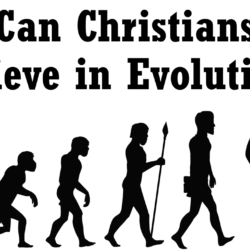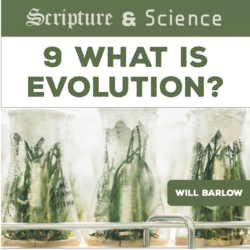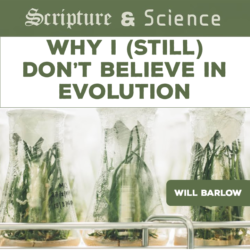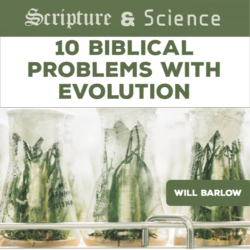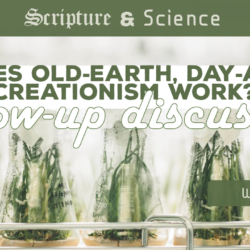Since it’s inception, evolutionary theory has remained controversial for many. Although one might think only uneducated laypeople find the idea unpalatable, quite a sizeable minority of scientists too struggle to come to terms with Darwinism. In today’s episode, Will Barlow explores a number of major scientific objections to evolution, including the Cambrian explosion, mutations as an insufficient mechanism, irreducible complexity, and the fossil record itself. Additionally, he briefly explores the issue of abiogenesis–the presumed starting point for any evolutionary development.
Listen to this episode on Spotify or Apple Podcasts
See below for notes.
—— Links ——
- We are doing follow-up discussions to these episodes on YouTube. Check them out!
- See other episodes in this Scripture and Science Class
- Check out Barlow’s previous podcast episodes
- Learn more about and support the church Barlow and his team are starting in Louisville, KY, called Compass Christian Church
- Find more articles and audios by Barlow on his website: Study Driven Faith
- Support Restitutio by donating here
- Designate Restitutio as your charity of choice for Amazon purchases
- Join our Restitutio Facebook Group and follow Sean Finnegan on Twitter @RestitutioSF
- Leave a voice message via SpeakPipe with questions or comments and we may play them out on the air
- Intro music: Good Vibes by MBB Attribution-ShareAlike 3.0 Unported (CC BY-SA 3.0) Free Download / Stream: Music promoted by Audio Library.
- Who is Sean Finnegan? Read his bio here
—— Notes ——
Scientific Objections to Evolution
• Evidence problems (open scientific questions)
• Methodological problems
• Evolution or design?
Evidence Problems
The theory of evolution has several major open problems that are yet to be solved:
• The Cambrian Explosion
• Mutations
The Cambrian Explosion
Much of the fossil record could be viewed in a light to support evolution, but the Cambrian Explosion poses a big problem:
• The theory of evolution requires slow changes over a long time
• Cambrian explosion was a big change in a short period of time
Simply put, what is the Cambrian explosion?
• Evolution would predict species would diverge and lead to new genera, families, orders, classes, and then phyla
• Most animal phyla (and many major classes within them) appear fully formed in the Cambrian period
“According to modern paleontologists James Valentine, Stanley Awramik, Philip Signor, and Peter Sadler, the appearance of the major animal phyla near the beginning of the Cambrian is ‘the single most spectacular phenomenon evident in the fossil record.’”
— Jonathan Wells, The Politically Incorrect Guide to Darwinism and Intelligent Design, page 16.
Some scientists have suggested that pre-Cambrian organisms might be too delicate to make good fossils
• Recent scientific discoveries have shown that this is untrue
• Scientists have found fossils in the Cambrian period that are small and soft tissued
Mutations
Mutations are considered incredibly important to the evolutionary framework:
• Recall that as populations are isolated and different conditions exist, random mutations lead to speciation (according to evolution)
• Recent studies on mutation have challenged this understanding
“Rather than mutations building up molecular machinery, improving an organism relentlessly, many mutations actually destroyed parts of a creature’s DNA, or rendered some of the molecular machinery it coded for ineffective. It turns out that some of the mutations which break things can sometimes have a salutary effect.”
— Michael Behe, “God and Evolution,” God is Great, God is Good, page 86.
Mutations that break genes can have a positive effect. For example:
• If a child receives the gene for sickle cell anemia from one parent and not the other, that child will experience more resistance to malaria
Evolutionist Richard Lenski and his team observed a situation in bacteria where two successive mutations improved the survivability of the bacteria.
However, there is one problem…
“The first mutations to help were the breaking of genes. The bacteria rapidly lost the ability to make the sugar ribose (a component of RNA); for some reason that helped the mutant bacteria compete against non-mutants. A handful of other genes involved in metabolism were also deleted. Some bacteria had their ability to repair DNA badly damaged. Most bacteria lost the ability to metabolize the sugar maltose.”
“The mutations were incoherent, scattered in different genes, with no recognizable theme among them. They were not in the process of building any new system in the cell. They simply took advantage of opportunities that helped them grow faster in their current milieu. This is what random mutation does, even when it ‘helps.’”
— Michael Behe, “God and Evolution,” God is Great, God is Good, page 89.
Methodological Problems
The theory of evolution has many methodological problems:
• Misleading Evidence for evolution
• Irreducible complexity
• The fossil record
• Origin of life
Misleading Evidence for Evolution
Proponents of evolution have used several pieces of misleading information:
• Haeckel’s embryos
• Miller’s origin of life experiment
Haeckel’s Embryos
If you look at many scientific textbooks, you will find a drawing of Haeckel’s embryos.
The problem is that they are fake!
Miller’s Experiment
Stanley Miller conducted a series of experiments in 1953 to demonstrate that life could spontaneously arise:
• Miller used an atmosphere of hydrogen, methane, ammonia, and water vapor — and life appeared!
• However, that atmosphere is not the scientifically accepted atmosphere
Irreducible Complexity
“If it could be demonstrated that any complex organ existed which could not possibly have formed by numerous, successive, slight modifications, my theory would absolutely break down.”
— Charles Darwin, The Origin of Species
Michael Behe (professor of biochemistry) believes that there are many examples that violate Darwin’s principles.
He calls these “irreducibly complex” things “machines.”
An “irreducibly complex” system is “a single system which is composed of several well-matched, interacting parts that contribute to the basic function, and where the removal of any one of the parts causes the system to effectively cease functioning.”
— Behe, Darwin’s Black Box, page 39.
Behe uses an example from modern life to explain what he means by an “irreducibly complex” system: a mousetrap.
Can a mousetrap work without a hammer, spring, or platform?
Behe give many examples in his book of systems that, from a biochemical perspective, are irreducibly complex:
• Blood clotting
• Bacterial flagellum
Responses to Behe:
• Collins says that most of Behe’s examples may have plausible solutions in the future
• Dawkins argues that there is not an “all or nothing” nature to certain examples Behe gives
• Lenski’s experiment showed that bacteria could see successive mutations (two-step machine)
The Fossil Record
What about the fossil record? It is perhaps the only place where we can scientifically observe speciation (the change in species over time).
Jonathan Wells challenges the fossil record.
Imagine that you dig in your backyard and find two skeletons! They are both dated to 30 years ago. One is adult sized and the other is half of that.
Can you assume a familial relationship?
We can apply this type of critical thinking to the fossil record. Just because two fossil specimens look like they are related does not make them related.
Consider archaeopteryx. Is it half-bird, half-reptile? Does it fit in the gap that evolutionists want?
It does not. The supposed reptilian precursors to this animal are found after it in the fossil record.
“We are not even authorized to consider the exceptional case of the archaeopteryx as a true link. By link, we mean a necessary stage of transition between classes such as reptiles and birds, or between smaller groups. An animal displaying characters belonging to two different groups cannot be treated as a true link as long as the intermediary stages have not been found, and as long as the mechanisms of the transition remain unknown.”
—Pierre Lecomte du Nouy, cited in Strobel, The Case for a Creator, page 58.
Origin of Life
Remember that evolution does not describe the origin of life — the theory begins when life begins.
However, it is interesting to challenge abiogenesis theories in conjunction with evolution.
Challenges to abiogenesis theories:
• The probability of randomly producing a “simple” protein are astronomically low
• No natural selection available before life begins
Evolution or Design?
What is the best conclusion given the evidence?
• If we believe in evolution, it still could be consistent with God-designed life and guidance.
• If we don’t believe in evolution, there is strong evidence for design in the living beings around us.
• Either way, atheism doesn’t do the best job of explaining the evidence.

